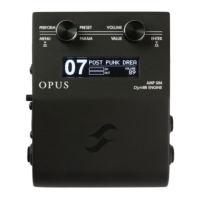Last update: 2023/11/06 14:11 opus:opus_user_s_manual https://wiki.two-notes.com/doku.php?id=opus:opus_user_s_manual
https://wiki.two-notes.com/ Printed on 2023/11/06 14:11
Connect your amplifier’s speaker output to the input of OPUS using a speaker cable
Set the IN LEVEL switch to AMP
Turn off the PREAMP and POWERAMP processing in OPUS
Check the input level VU Meter on OPUS' OLED display; if the display indicates clipping of the
input signal, navigate to the pedal’s MENU using the Rotary Encoders, and scroll to the GLOBAL
section. Enter the section, and scroll to the INPUT PAD page - Set it to ON to apply a 10dB
reduction of your input signal to negate clipping OPUS’s input stage
Connect the XLR output to an audio interface or mixing desk to send your amp’s signal
complete with OPUS’ DSP processing to your computer or Front Of House respectively. In this
instance, traditional miking of a cabinet is no longer required as OPUS handles all cabinet
simulation and the associated miking process courtesy of the on-board DynIR™ engine.
—-

